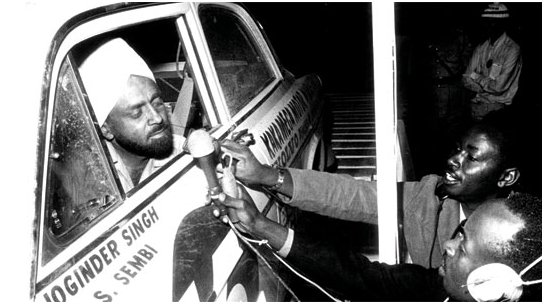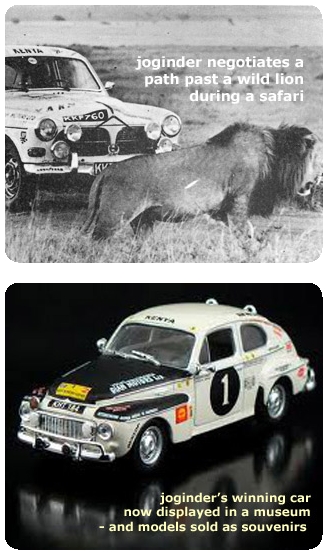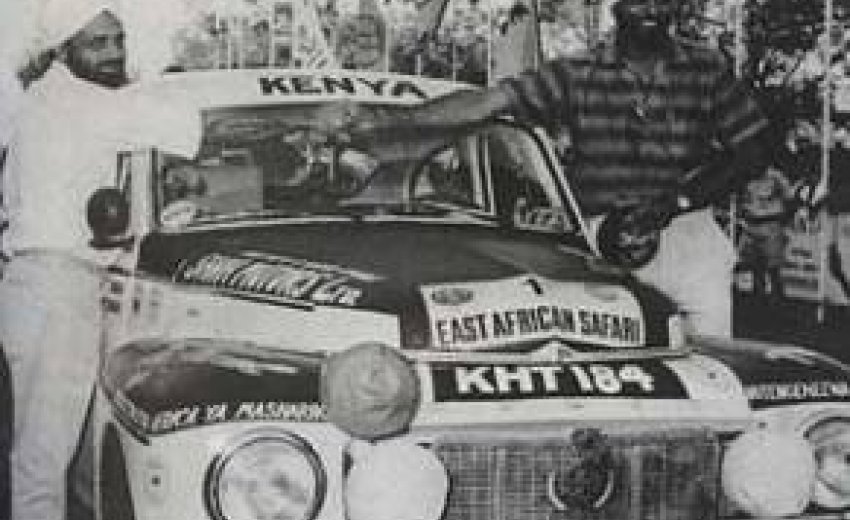
PHOTO | FILE Joginder Singh in an interview with journalists at Jamhuri Park during the
East African Safari Rally on March 26, 1967. NATION MEDIA GROUP
Friday, January 11 2013: If you want to understand the greatness of Joginder Singh, do not look at the 22 times that he entered the East African Safari Rally and failed to finish only three. Do not analyse his three wins, which were the first by any competitor. Do not even go to his retirement home in Surrey, England and marvel at the trophies, certificates, books, newspapers, magazines and documentaries that chronicle his victories in motor rallies around the world.
Instead, go back to 1971. There you’ll find his second worst placing in the Safari besides the three retirements in 1972, 1975 and 1978. He finished 16th overall in his works prepared Ford Escort Twin-Cam. But that is where to start. It is there that you’ll find the confluence between the myth and the reality which, in Joginder’s case, are one and the same thing.
By this time, he was already lionized as The Flying Sikh and Simba wa Kenya. He had attained a superhuman status in the psyche of one generation of Kenyans and they need not necessarily have been motor sport fans. Little boys curved cars out of cartons and affixed wheels of soda and beer bottle tops and trailed them around in an imaginary Safari route shouting ‘Joginder! Joginder! Joginder!’ Only the winners qualified to claim that title because Joginder could never be second best.
Maybe one of these boys was Patrick Njiru, probably Kenya’s most talented African rally driver who years later as an ace in his own right, spoke about his earliest inspiration. He said: “Joginder Singh.”
He was a rare breed whose appeal lay in a sublime neutrality so that the millions who loved him – people who lived in mental ethnic and racial cocoons - didn’t see a Sikh or an Asian; just a motoring superman. The profundity of this quality was such that it needed no words to propagate and few of the multitudes who were enamoured of The Flying Sikh have ever heard him speak.
Who, really, was Joginder Singh?
The 1971 Safari Rally was just a few hours underway when a nylon bush in the gearbox of Joginder’s Ford Escort melted at the foot of the Taita Hills, leaving only the reverse gear functioning. Joginder decided to return to where his service crew was and drove the car backwards for four and a half kilometres with a screw driver in place of the gear lever.
He explained: “At Ndi, in the very early stages of the Safari, we met the service team before the turn-off to the Taita Hills. After we took the turn four and half kilometres later, I found I had no gear in a corner. I stopped the car and tried all the gears. I discovered I had only the reverse gear left. So I reversed all the way, back to the service crew. All this time, about 70 more Safari cars were coming flat out towards me as I was reversing.
“On reaching the service point, we found the Ford crew had gone. Only two mechanics remained. We just opened up the gearbox and stripped it to bits. The gear selector had broken. There were no spare parts, not even at Mombasa or Dar es Salaam. We bent the levers in the gears so as to stick them in and put it all back into place. It took a lot of hammering to bend the steel rods to make them work. This took a lot of precious time.
Overtaking tail-enders
“As soon as we got back on the road, we let go at full speed. We started overtaking the tail-enders. We were right at the end. I remember overtaking Car No. 115 and we carried on overtaking them in the Taita Hills and on the stretch to Mombasa. We were the 100th car at one stage and we just kept overtaking them.”
In fact, just as Joginder had linked up with his two mechanics after the epic reverse drive, Stuart Turner, the Ford Team Chief, circled overhead in his plane and Joginder frantically waved his useless gear lever at him.
But Turner had already decided that Joginder’s case was hopeless and radioed the service crew to pursue Finland’s Hanu Mikkola, the other driver upon who all Ford’s hopes now lay as far as Turner was concerned. Mikkola would, the following year, become the first overseas driver to win the East African Safari – but that is a story for another day. Turner left Joginder to his own devices.
 |
| Photo Source: http://sikhchic.com/article-detail.php?id=3961&cat=8 |
But the enormous loss of time had consigned him to a 16th place finish on points.
That drive is etched in the memory of Kenya. KBC radio, the only live media available to the nation, had periodic progress reports of the Safari and Kenyans followed the broadcasts with probably as much interest as Americans had showed with their first trip to the moon.
At the ramp at KICC, commentators and ordinary fans searched for words to describe Joginder. All questions by journalists basically amounted to only one: how had he done it? One journalist reported that many people “just wanted to touch the car that had done so well.”
Joginder, of course, had a critical advantage over many other drivers and he used it to the fullest. In his 1966 book, The Shell History of the East African Safari Rally, Charles Disney had this observation to make: “The Kenya-born Sikh brothers, Joginder and Jaswant Singh...had driven together since 1960 and had never failed to finish, never being lower in the ratings than fifth in their class.
“They had gained a class win and three class seconds and, in 1963, had been one of the seven crews to complete the Safari, finishing fourth. Both are good drivers and excellent mechanics, able to assemble, tune and prepare their cars themselves as well as being able to effect any necessary repairs en route without recourse to outside assistance.”
That is what Stuart Turner had not reckoned with. In 1971, Joginder’s co-driver was Jaswant. He was another gift. Ashok Bhalla, now Manager at the East African Safari Rally Ltd, which runs the Safari Classic, navigated Joginder in a series of local rallies. He noticed something early on.
“Joginder never forgot a bend,” says Bhalla. “He drove around it once and memorized its details – sharpness of angle, gradient of terrain, type of surface and all that. Next time we went there, he took it at the maximum speed possible. He combined the roles of driver and navigator.”
Navigated many drivers
This is collaborated by a Joginder fan, John Kagagi, better known as a rugby referee and game authority than a motor sportsman. “As small boys growing up at Itiati on the slopes of Mt Kenya, we eagerly awaited the Safari cars every Easter. Ours was a place marked by a series of hairpin bends. Joginder knew them like the back of his hand. He negotiated them at a speed nobody else could to our great thrill.”
But it is Surinder Thathi, a vice-president of the FIA, the International Automobile Federation, who paints the most poignant, most nostalgic and probably the most complete picture of the legendary driver.
He remembers: “As a little boy, I used to go to the entrance of Joginder Motors on Koinange Street and just stand there, watching my hero work. I stood and stood until Joginder came over and ordered me ‘go home now. Go and do something else.”
“I could never have enough. Many years later, after I had become a motor sportsman, I went to Joginder and said to him: ‘Joginder, I have navigated many great drivers. I have navigated Mike Kirkland; I have navigated Vic Preston Junior, Rauno Aaltonen, Avin Weber, Patrick Njiru, Ian Duncan and many others. You are the greatest driver that I’ve never had a chance to navigate. Please give me a chance.’ Joginder shook his head and said to me: ‘Sorry, my rallying days are over.’ And indeed they were. That was in 1996.”
Thathi says he missed and marvelled at the way Joginder took sharp corners.
“He approached them at high speed and then twisted the car so that it fully faced the bank on its side before pulling off. This was completely contrary to how Shekhar Mehta did it. Shekhar turned his corners ‘clean’. Vic Preston Jr was somewhere in between Joginder and Mehta.” Shekhar Mehta won the Safari a record five times – another story for another day.
Joginder Singh Bachu was born on February 9, 1932 in Kericho, the eldest of eight sons and two daughters born to Batan Singh Bachu and his wife Swaran. His father had sailed into Kenya in the 1920s in a small dhow from the Punjab region of India. By his own reckoning, he and his brothers Jaswant and Davinder took much after their father who worked as an engineer in the Kimungu factory of the Kenya Tea Company, a subsidiary of Brook Bond Kenya Ltd.
First class mechanic
Engineer the elder Bachu was but not from anybody’s university. He was self taught. In an account of his early life given to Roger Barnard and Peter Moll for their 1975 book, The Flying Sikh, illustrated by Mohammed Amin, Joginder said: “My father came from a village called Kandola near Jallunder in the Punjab. He was a big man – over six foot and weighing perhaps 220 lbs. He may have lacked education, but like so many of our people, he was very good with his hands.
“He was a first class mechanic, mason, carpenter...anything. For instance, after the last war, tools were very difficult to obtain. My father made his own. We still use some of them today in the garage. Throughout his life, he was a man of principle, a very honest man. For him, there was no cheating, no lies. But he was very quick-tempered. He often used to beat me. That’s how I learnt. Otherwise, I wouldn’t know half as much.”
Joginder went to Highland Indian School in Kericho until 1946 before being enrolled at Indian High School in Nairobi, later called Duke of Gloucester School, and today Jamhuri High School.
He described himself as a village boy who was always homesick while in school in Nairobi. He longed for Kericho, where his father already had a name for kicking up tremendous clouds of dust in his wake as he drove fast to and from work on the dirt roads. Unknown to him, the teenaged Joginder was watching, and itching to do the same.
Lost left thumb
But he had a friend whose father ran a saw mill in what is now Baricho Road in Nairobi’s Industrial Area. “In 1947,” recalled Joginder, “on a visit to the saw mill, I lost my left thumb. I was lucky not to lose my life. I was looking at the machines and noticed a belt hanging loose. I pulled at it and caught my hand in a pulley. I was thrown 20 ft away.
“Where my thumb should have been there was just a bloody pulp. When my father heard about it, he drove to Nairobi in four and a half hours. In those days, it was a great time for over 200 miles of marrum road. I think that feat almost made the loss of my thumb worthwhile.”
This thrill with speed became an all-consuming passion, as his later career proved. Once, in 1966 during the Swedish Rally, he arrived at a control point ahead of time. Sikhs with their distinctive head dress were a rarity in the country. A woman saw Joginder and was almost hysterical with concern seeing the heavy ‘bandage’ he was wearing on his head.
“He’s hurt....!” she exclaimed. “Get a doctor!” Because Joginder had arrived early, he had sufficient time to explain to the woman that he was alright and further enlightened her on the significance of his turban.
Embodiment of driving discipline
About 10 years ago, Joginder developed problems with his heart. He underwent by-pass surgery that apparently didn’t solve the problem. Today, life in his Surrey home with his wife is about going and coming back from hospital. He will be 81 next month. It is very difficult, just coming to terms with Kenya’s lion in winter – in the late afternoon of his life.
The superman of speed has always been the embodiment of driving discipline away from the rally tracks. “Often,” he said of some of his compatriots during his competition days, “drivers recognise me when I am on the road, perhaps just going to work or picking up my son from school. They have to prove that they are faster than me. It can be hair-raising at times. In town, I drive cautiously and obey the traffic regulations. It pays.”
Just the mention of his name, and the ears itch to hear the crank of a motor starter and to listen to the roaring response of a rally car’s engine. His place as one of the most imminent Kenyans of the last 50 years is assured. And to take in his fading away from the rallying scene – it is haunting.
Roy Gachuhi, a former Nation Media Group sports reporter, is a writer with The Content House
------------------------------
Related Articles: ![]() ~ JOGINDER SINGH
~ JOGINDER SINGH
If anyone in East Africa achieved the status of a national hero through motor rallying, it was undoubtedly Joginder Singh. He was not only the first Asian driver ever to win an international rally but also the first man to win the Safari three times. His tally of 19 finishes in 22 Safari starts is unique: a record of consistency in 'the world's toughest rally' that will probably never be beaten.
Sardar Joginder Singh Bhachu was born on 9th February 1932 at Kericho in Kenyan in the western highlands. His father Sardar Battan Singh came to Kenya in the 1920's from Village Kandola Kalan, near NurMahal in the district of Jullundur, Punjab. His mother's name was Sardarni Swaran Kaur. Joginder Singh was the eldest of eight sons and two sisters and was educated at a boarding school at Nairobi. But engineering was already in his blood as he was able to drive an old 1930s Chevrolet by the time he was 13......more
Tears in triumph at the ramp.....
The banner headline of the Daily Nation of April 20, 1976 screamed: Simba’s Tearful Triumph.......more

